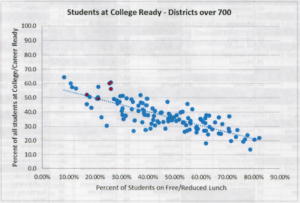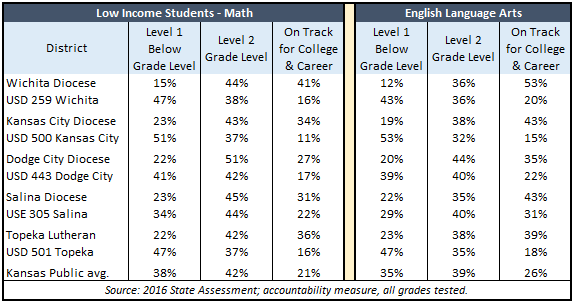The Kansas Association of School Boards tried to give legislators the impression that public schools do just as well as private schools like Catholic and Lutheran schools when adjusting for poverty rates, but the real data shows otherwise. This scatter plot chart was included in their testimony last week, with the red dots showing the Catholic Dioceses and Lutheran schools.
But KASB didn’t tell legislators that they weren’t  showing an apples-to-apples comparison of how low income students perform in public and private schools. Their sleight-of-hand chart merely demonstrates that districts with high poverty levels have lower overall scores because of large achievement gaps for low income kids. Everyone in education and the Legislature knows this, so why would they attempt to deceive in this manner?
showing an apples-to-apples comparison of how low income students perform in public and private schools. Their sleight-of-hand chart merely demonstrates that districts with high poverty levels have lower overall scores because of large achievement gaps for low income kids. Everyone in education and the Legislature knows this, so why would they attempt to deceive in this manner?
Because an honest performance comparison shows exactly the opposite of what they want legislators to believe. When looking at apples-to-apples comparisons of low income students’ achievement for the Catholic/Lutheran schools and public schools the truth is simple and clear – those private schools do better than public schools at educating their most at-risk students.
In every match up, the Catholic Diocese or Lutheran school have much smaller percentages of low income students performing below Grade Level and much higher percentages of low income students on track for college and career than the home district.
 Of course, a Diocese covers a broader geographic region than just the home public school district; the next chart shows how those private schools compare against all public school districts. The worst performing – Dodge City Diocese – does better than 191 public school districts for percentage of low income students on track in Math and outperforms 245 public districts on English Language Arts. The best among these private options – Wichita Diocese – outperforms nearly every public district.
Of course, a Diocese covers a broader geographic region than just the home public school district; the next chart shows how those private schools compare against all public school districts. The worst performing – Dodge City Diocese – does better than 191 public school districts for percentage of low income students on track in Math and outperforms 245 public districts on English Language Arts. The best among these private options – Wichita Diocese – outperforms nearly every public district.
 It’s not merely pride that prompts KASB to mislead legislators and the public. The purpose of their testimony was twofold. They hoped to dissuade legislators from allowing low income students to use tax credit scholarships or education savings accounts to go elsewhere and get the education they deserve, saying the data “does not support the idea that [expanding those programs] would result in better state performance.”
It’s not merely pride that prompts KASB to mislead legislators and the public. The purpose of their testimony was twofold. They hoped to dissuade legislators from allowing low income students to use tax credit scholarships or education savings accounts to go elsewhere and get the education they deserve, saying the data “does not support the idea that [expanding those programs] would result in better state performance.”
Their other motivation was defeating the proposal to hold public schools accountable by grading buildings A-F based on state assessment scores, providing rewards for improvement but consequences otherwise. School officials don’t want parents and legislators knowing the simple, clear truth – private schools do better than public schools at educating their most at-risk students. They’d rather keep those students trapped in public schools so they can keep the money that comes with them.
Once again, KASB and their school district members are only too willing to put their institutional interests ahead of students getting the education they deserve. They want you to believe it’s all about the kids, but it’s really all about the money.




